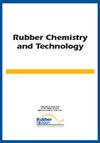INTRODUCING TEA POLYPHENOLS AND VITAMIN C TO IMPROVE THE IN SITU HYDROGENATION AND REDUCTION PROCESS OF NBR AND NBR/GO LATEX
IF 1.5
4区 工程技术
Q4 POLYMER SCIENCE
引用次数: 0
Abstract
Tea polyphenols and vitamin C are used as reducing agents that are introduced into nitrile–butadiene rubber (NBR) and NBR/graphene oxide (GO) latex systems, and the double bonds in the NBR and the GO sheet in NBR/GO are simultaneously hydrogenated and reduced through the synergistic hydrazine hydrate/hydrogen peroxide/copper sulfate catalytic system to prepare hydrogenated NBR (HNBR) and HNBR/reduced GO (RGO) nanocomposites. The degree of hydrogenation of the product is improved and the gel content of the product is reduced, which effectively solves the problems of the low degree of hydrogenation and high gel content in the diimide catalytic hydrogenation system. At the same time, the HNBR and HNBR/RGO nanocomposites, which are co-reduced by tea polyphenols and vitamin C, have good thermal stability and mechanical properties. Tea polyphenols are more likely to participate in the hydrogenation reaction. The degree of hydrogenation of the NBR double bonds is higher than the amount of reduction occurring within the GO sheet with the addition of tea polyphenols.引入茶多酚和维生素c,改进丁腈橡胶和丁腈橡胶/氧化胶乳的原位加氢还原工艺
茶多酚和维生素C被用作还原剂,引入丁腈橡胶(NBR)和NBR/氧化石墨烯(GO)胶乳系统中,通过水合肼/过氧化氢/硫酸铜协同催化体系,使NBR中的双键和NBR/GO中的GO片同时氢化和还原,制备氢化NBR(HNBR)和HNBR/还原GO(RGO)纳米复合材料。提高了产品的加氢程度,降低了产品的凝胶含量,有效解决了二亚胺催化加氢体系中加氢程度低、凝胶含量高的问题。同时,茶多酚和维生素C共同还原的HNBR和HNBR/RGO纳米复合材料具有良好的热稳定性和力学性能。茶多酚更有可能参与氢化反应。NBR双键的氢化程度高于加入茶多酚时GO片内发生的还原量。
本文章由计算机程序翻译,如有差异,请以英文原文为准。
求助全文
约1分钟内获得全文
求助全文
来源期刊

Rubber Chemistry and Technology
工程技术-高分子科学
CiteScore
3.50
自引率
20.00%
发文量
21
审稿时长
3.6 months
期刊介绍:
The scope of RC&T covers:
-Chemistry and Properties-
Mechanics-
Materials Science-
Nanocomposites-
Biotechnology-
Rubber Recycling-
Green Technology-
Characterization and Simulation.
Published continuously since 1928, the journal provides the deepest archive of published research in the field. Rubber Chemistry & Technology is read by scientists and engineers in academia, industry and government.
 求助内容:
求助内容: 应助结果提醒方式:
应助结果提醒方式:


